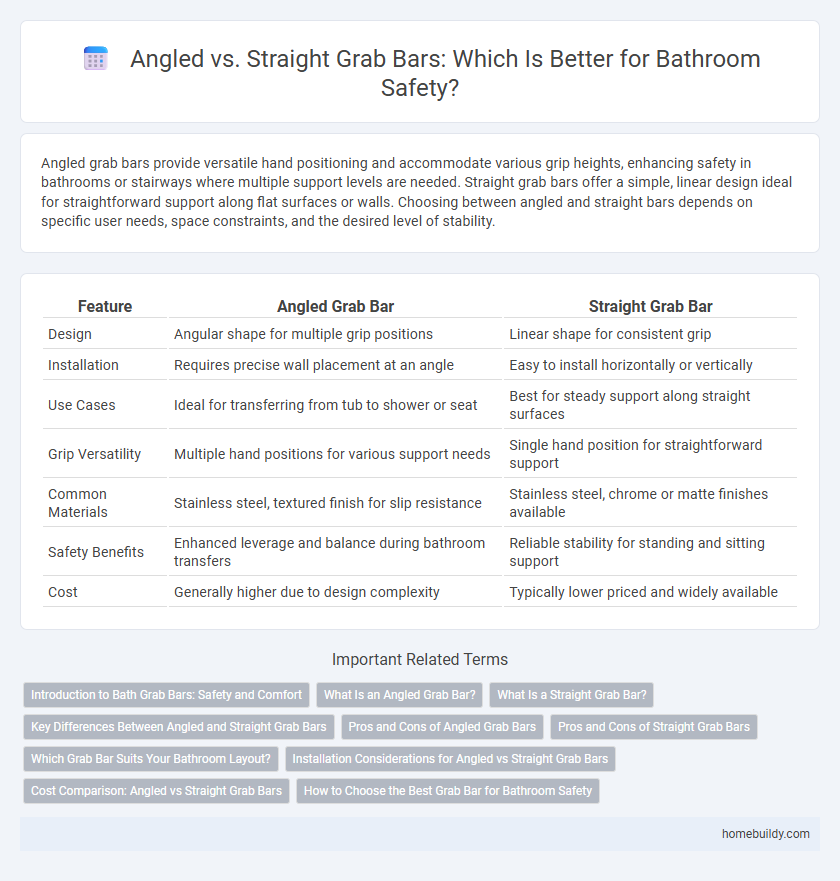Angled grab bars provide versatile hand positioning and accommodate various grip heights, enhancing safety in bathrooms or stairways where multiple support levels are needed. Straight grab bars offer a simple, linear design ideal for straightforward support along flat surfaces or walls. Choosing between angled and straight bars depends on specific user needs, space constraints, and the desired level of stability.
Table of Comparison
| Feature | Angled Grab Bar | Straight Grab Bar |
|---|---|---|
| Design | Angular shape for multiple grip positions | Linear shape for consistent grip |
| Installation | Requires precise wall placement at an angle | Easy to install horizontally or vertically |
| Use Cases | Ideal for transferring from tub to shower or seat | Best for steady support along straight surfaces |
| Grip Versatility | Multiple hand positions for various support needs | Single hand position for straightforward support |
| Common Materials | Stainless steel, textured finish for slip resistance | Stainless steel, chrome or matte finishes available |
| Safety Benefits | Enhanced leverage and balance during bathroom transfers | Reliable stability for standing and sitting support |
| Cost | Generally higher due to design complexity | Typically lower priced and widely available |
Introduction to Bath Grab Bars: Safety and Comfort
Angled grab bars offer enhanced ergonomic support by accommodating natural grip positions and providing stability at multiple angles, making them especially useful for transitioning between sitting and standing in the bath area. Straight grab bars deliver straightforward support with a consistent grip surface, ideal for users seeking simple, linear assistance. Both types improve safety and comfort, reducing the risk of slips and falls in wet environments by offering reliable handholds tailored to different mobility needs.
What Is an Angled Grab Bar?
An angled grab bar is a safety device installed in bathrooms, designed with a diagonal shape to provide multiple grip positions for enhanced support and stability. Unlike straight grab bars that offer a single horizontal or vertical grip, angled grab bars accommodate natural arm movements, making transfers and balance easier for users with limited mobility. These bars are commonly used near toilets, showers, and bathtubs to improve accessibility and reduce the risk of falls.
What Is a Straight Grab Bar?
A straight grab bar is a horizontal safety rail typically installed in bathrooms to provide support and stability for users, especially in showers and near toilets. It is designed to offer a secure handhold, reducing the risk of slips and falls by allowing users to maintain balance. Straight grab bars are commonly constructed from stainless steel or other rust-resistant materials, ensuring durability in wet environments.
Key Differences Between Angled and Straight Grab Bars
Angled grab bars provide enhanced ergonomic support by accommodating natural wrist and arm positions, making them ideal for transferring in and out of bathtubs or showers. Straight grab bars offer straightforward, linear support primarily suited for stability along flat surfaces, such as bathroom walls. The key difference lies in their shape and placement, which directly impact user mobility, grip comfort, and safety during bathroom activities.
Pros and Cons of Angled Grab Bars
Angled grab bars provide versatile support by accommodating multiple grip positions, enhancing safety on stairs or near tubs where different hand angles are needed. Their design promotes better leverage and stability, especially for users with limited wrist mobility or strength. However, angled bars can be more challenging to install and may occupy more wall space compared to straight grab bars, which are simpler and often preferred for uniform support along flat surfaces.
Pros and Cons of Straight Grab Bars
Straight grab bars provide a stable support surface for users, ideal for simple, linear movements such as standing up or sitting down. They are easier to install and often more affordable compared to angled grab bars, making them a cost-effective solution for bathroom safety. However, straight grab bars may offer less versatility in grip positions and leverage angles, potentially limiting support during complex movements or transfers.
Which Grab Bar Suits Your Bathroom Layout?
Angled grab bars provide versatile grip positions, making them ideal for bathrooms with limited space or where multiple support points are needed, especially near toilets or showers. Straight grab bars work best in spacious bathroom layouts, offering a simple and sturdy support line for balance and stability along long wall sections. Choosing between angled and straight grab bars depends on the specific layout, user mobility needs, and placement flexibility to maximize safety and convenience.
Installation Considerations for Angled vs Straight Grab Bars
Angled grab bars require more precise positioning to accommodate natural grip angles and body movements, often necessitating professional installation to ensure optimal placement and safety. Straight grab bars are generally easier to install due to their uniform shape, allowing standard mounting heights and straightforward attachment to wall studs. Both types demand secure anchoring, but angled bars may involve additional wall reinforcement to support varied leverage points.
Cost Comparison: Angled vs Straight Grab Bars
Angled grab bars generally cost more than straight grab bars due to their complex design and added material requirements, with prices ranging typically from $50 to $150 compared to $30 to $100 for straight bars. Installation costs can also vary, as angled bars might require more precise mounting for optimal support, potentially increasing labor fees. Budget-conscious buyers often prefer straight grab bars for their affordability and ease of replacement, while angled bars offer enhanced ergonomic support at a higher price point.
How to Choose the Best Grab Bar for Bathroom Safety
Choosing the best grab bar for bathroom safety depends on the user's mobility and support needs; angled grab bars provide versatile hand positioning and better leverage for standing or sitting, while straight grab bars offer consistent grip along a linear path. Consider wall space, installation height, and personal comfort to ensure maximum stability and fall prevention. High-quality stainless steel bars with textured finishes improve durability and grip, enhancing overall bathroom safety.
angled grab bar vs straight grab bar Infographic

 homebuildy.com
homebuildy.com